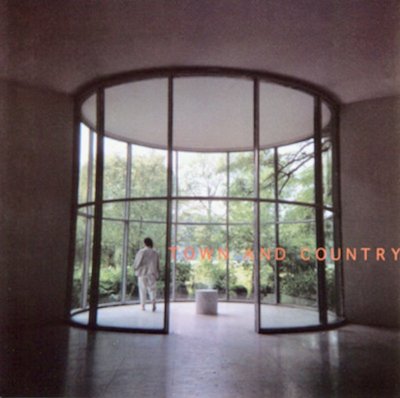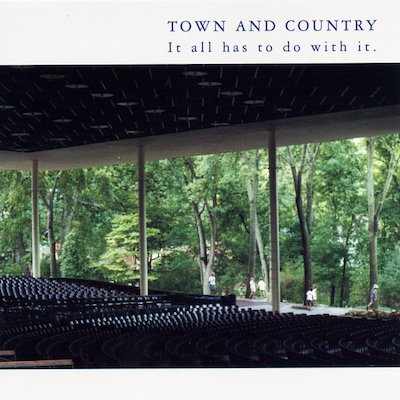Dec. 20, 2022
I recently read You're with Stupid by Bruce Adams, a detailed and reasonably opinionated insider’s history of the Chicago underground music scene in the 1990s and early 2000s. While it touches on a few of the more famous Chicago bands of that era (Smashing Pumpkins, Liz Phair, Wilco, Ministry), the primary subject is the community of more experimental artists whose music came to be called "post-rock" by some journalists – Tortoise, Isotope 217, Jim O'Rourke, The Sea & Cake, etc. – and especially artists associated with the adventurous record label kranky, which Adams co-founded.
I enjoyed the book and learned a lot, since my knowledge of that music is spotty (confession: I had somehow never listened to Labradford until now), but I was surprised by what struck me as a glaring omission: As far as I can recall, Adams never gives more than a cursory mention to the group Town and Country. Not even an index entry.
Town and Country were an all-acoustic quartet that played a kind of quiet, folky take on minimalism and drone-based music using a core instrumentation of two contrabasses, steel-string acoustic guitar, and small harmonium, with some players doubling on trumpet, piano, and percussion. Band members Josh Abrams, Jim Dorling, Liz Payne, and Ben Vida came together in 1997, and have a rich collective history of playing underground rock, jazz, and improvised music. The resulting chemistry is a bit like John Fahey and Tony Conrad paying homage to Morton Feldman.
This is one of the few groups from that Chicago post-rock scene whose albums I actually own – all six of them, in fact. All of the group members were (and still are) very active in the segment of the music community Adams writes about. They played in the same clubs as those other bands, and most of their recordings were released on the hip Thrill Jockey label, so it doesn't seem unreasonable to expect them to figure a bit more prominently in his narrative.
But apparently Town and Country were outliers, in spite of their post-rock pedigree. Aside from a couple of short pieces in the Chicago Reader and a handful of snarky Pitchfork reviews that rag on them for not sounding enough like a rock band, it seems there is no critical writing about them to be found online. This made me wonder if I've had a misplaced idea of their importance for all these years. Maybe I’ve been deluded and everyone but me thought they were terrible? It's been a while since I listened to them, so I decided to revisit all of their albums to see how they hold up. (Clicking the album titles below leads to the music.)
Town and Country (1998)
I don't recall exactly how I came to their first, self-titled album. It could have been in 2000, when Brent Gutzeit, who released it on his BOXmedia label, played in Albuquerque and perhaps gave it to me. Or I may have got it from my friend Philip Hertz, who worked with Bruce Adams at Cargo distribution in Chicago. Either way, I was happy to hear it then and still enjoy it now. To be honest, it was kind of a revelation; I’ve secretly wanted to start a band like this ever since hearing it. Opening with tuning forks resonating on the bass bodies, the mood remains spacious, unhurried, and hypnotic across all five pieces, which range in length from five to twenty-one minutes. The acoustic guitar plays finger-picked repeating figures and semi-dissonant chords, the harmonium drones in close intervals, and the basses alternate between plucked riffs and bowed long tones. The compositional forms are reductive but not so rigorous as to feel uptight. It's hard to know to what extent improvisation might be involved, but if it is, it's not at all obvious. There's a humble, homemade quality to this that I find appealing. It reminds me a little of British composer Jan Steele's early work, which is a good thing. A strong initial statement of intent that still holds up nearly twenty-five years later.
Decoration Day (2000)
Their second release (and their first on Thrill Jockey) was this three-song EP. It builds on the basic concept of the first album, expanding the instrumentation to include piano, kalimba, celeste, accordion, second guitar, and snare drum. That change was in large part an adaptation to a serious hand injury suffered by bassist Liz Payne. The compositions are a bit more fleshed-out, not quite as repetitive, and the broader tonal palette makes for added interest. This one's kind of a placeholder, a tasty and satisfying amuse-bouche to whet the appetite for the album to come.
It all has to do with it (2000)
Continuing the evolution heard on Decoration Day, their third release and first full album for Thrill Jockey adds even more new instruments to their palette (bells, vibes, trumpet) and finds them further developing their compositional range, citing Don Cherry, Franco Batiato, Gavin Bryars, and Sonny Sharrock as influences (along with Fahey and Feldman). Those influences aren’t entirely apparent to me, but I’ll give them points for eclecticism. The tempo of the first track is almost peppy compared to all that came before. The middle two tracks are more reminiscent of the first album – slower tempos, more drone-based. The last piece is kind of a weird mutation, using two woozy, loopy acoustic slide guitars and a trumpet melody over repeated bass figures and a percussive (really!) accordion drone, culminating in a coda of bass and finger-picked guitar over a bed of high-pitched bowed bowls. If like me you appreciated the first two records, there's no reason not to enjoy this one. (In a similar related vein, see also guitarist Ben Vida's lovely solo guitar album from around this time, Mpls.)
C'mon (2002)
This fourth release contains a whopping seven songs, three of which are under five minutes long. Much of it more or less picks up where the last album left off, continuing with the formula of semi-glacial repeating patterns accompanied by free reed drones and tinkling, gamelan-like celeste, but adding bass clarinet, cornet, and hand bells. The second track, I'm Appealing, however, is a departure; the two acoustic guitars and something percussive (bell? celeste? vibraphone?) play fast repetitive patterns that sound electronically looped but are played in real time. These make occasional sudden changes a la Steve Reich or Philip Glass. I Am So Very Cold is nearly sprightly, evolving into something that almost feels like a samba by the end. The final track, Bookmobile, is another bubbly up-tempo number, propelled by handclaps until it downshifts in the final third, allowing the interlocking individual lines to come into focus and revealing the underlying structural framework. Aside from one piece in the middle that kind of drags, I have no objections. The ways they change from album to album are more interesting to me than in how they stay the same.
5 (2003)
On Town and Country’s lazily-titled fifth release, the opening track Sleeping in the Midday Sun (no discernable relation to John Cale's Buffalo Ballet) begins in pretty typical T & C drone territory, but about four minutes in the bass and horns are replaced by rather exciting percussion (rattles, triangle, something else), sounding a bit like Penguin Cafe Orchestra. Weren't expecting that, were you? Nor were we expecting the blast of cacophonous string noise that opens Lifestyled and pretty much lays out the vibe of the rest of the piece. Closing track Shirtless brings back the percussive accordion effect not heard since their second album, adding bass clarinet, maracas, and celeste to evoke a garage band take on Steve Reich's Music for Eighteen Musicians.
Up Above (2006)
And now, for something completely different. T & C's final album finds them still working the drone field, but in a more energetic fashion. Tonally, things may remain pretty static, but there's a lot happening rhythmically. Instead of long, slow notes, these drones are built on lots of short, fast ones. And the instrumentation has expanded yet again, adding mouth harp, khaen (bamboo mouth organ), shakuhachi (Japanese bamboo flute), mandolin, violin, tambura (Indian string drone), glockenspiel, karkabas (metal castanets), guimbri (Moroccan bass lute), pipe organ, and vocals (no words). This vastly expanded sonic palette seems to have come, at least in part, from a tour in Japan. The compositional shift may have been inspired by touring with drone-meister Tony Conrad, which seems likely but is not entirely obvious. Oh, and there are covers! Blue Lotus Feet is a yoga kirtan (devotional chant) and King of Portugal is their take on a traditional Portuguese Christmas song, though I'm not sure how recognizable either of those are here. Someone might accuse the band of appropriating various world music traditions, resulting in a kind of Fourth World gumbo that's neither here nor there. (The Chicago Reader said it sounds “like someone made an album of mashups using the African and Southeast Asian volumes of the Nonesuch Explorer Series.”) But I'm inclined to give them the benefit of the doubt and imagine them applying these exotic instrumental colors for purely sonic reasons, to add new sounds to what they'd been developing all along rather than intending to evoke the music of other cultures. The title track that closes the album is perhaps the least restrained thing they ever recorded, sounding like a dense free improv drone jam without much predetermined form (note the fade-in at the beginning; this is obviously excerpted from a longer piece). In a way, it's an incongruous place to end their run, but it may also be an indication that they'd taken this particular idea to its logical conclusion (and/or back to where they began). Where would they go from there? But aside from that last piece, it's a pretty successful album overall.
So, having immersed myself in this music again for the past few days, I'm still a believer. It's true that Town and Country were never as accessible as other alternative instrumental chamber groups like Rachel's, or Penguin Cafe Orchestra, or Tin Hat Trio, but I doubt that was ever their intention. From the outset, they traveled a more challenging experimental path, related more to hardcore early minimalism than to anything remotely resembling a rock band. That was always going to be a tough sell, and anyone expecting them to conform to even the expanded conventions of post-rock was in for a disappointment. But taken on their own terms, I think Town and Country successfully merged experimental aesthetics with indie rock ethics. What they were doing was probably better suited to playing in art galleries than rock clubs, but they did the latter against the odds, without compromising, and for that they have my lasting respect. Maybe someday the rest of the world will rediscover them and acknowledge their contribution.
Further reading, listening, and watching
Josh Abrams on BandCamp.
Jim Dorling discusses Town and Country and plays selected tracks along with some of their influences on this podcast.
Ben Vida on BandCamp.
Town and Country live, 1999.
Town and Country live, 2000.
Town and Country live, 2002.





